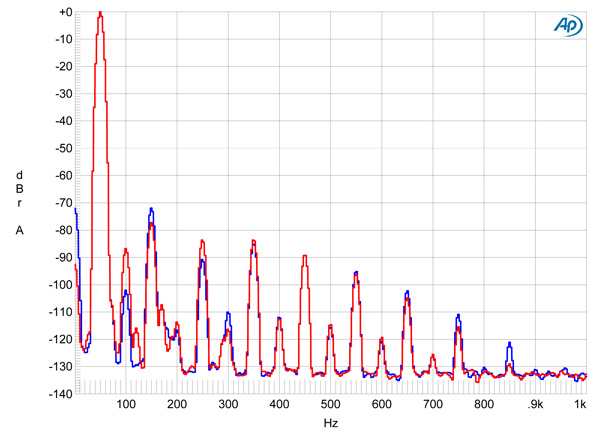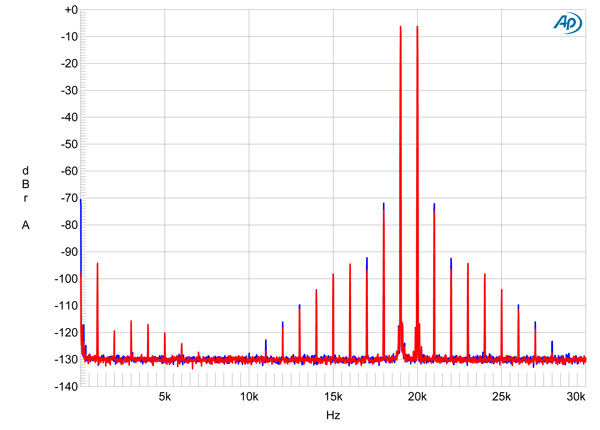| Columns Retired Columns & Blogs |
An excellent review. If this model is half as good as the AX-5 Integrated, it is a keeper.
When I examined the Ayre Acoustics EX-8 2.0's performance on the test bench, to accompany Ken Micallef's review in the November 2021 issue, the two channels behaved somewhat differently. The right channel's output impedance was higher than that of the left—0.525 ohm vs 0.35 ohm, which resulted in a level imbalance of 0.2dB into 8 ohms—and while the distortion was predominantly third-harmonic in the left channel, it was predominantly second-harmonic in the right channel.
Ayre Vice President & CTO Ariel Brown emailed me after he had seen the preprint of the review; manufacturers are always sent a copy of the review so that they may correct any factual errors and write a Manufacturer's Comment. He was puzzled by the differences in the behavior of the channels and conjectured that one of the pairs of complementary output devices in the right channel was effectively out of the circuit and not contributing as it should, perhaps due to a cold solder joint. Ayre tests its products with an Audio Precision analyzer before they leave the factory, so why would there be a cold solder joint with the review sample, especially as Ken Micallef had been impressed with its sound quality?
It appeared that the review sample had suffered some kind of shock in transit from Ken Micallef's place to mine—the top panel was dented—and that shock may well have caused a marginal solder joint to open. Ariel Brown shipped a new sample of the EX-8 2.0 to me for measurement. The original sample's serial number was 27G-0103; the new sample's was 27C-0002.
As before, I measured the new sample with my Audio Precision SYS2722 system). The voltage gain, input impedance, maximum power, and signal/noise ratios were all identical to those of the original sample, but the frequency responses of the channels now matched much more closely (fig.1).

To calculate an amplifier's output impedance, I examine the voltage divider formed by the series connection of the output impedance and the load resistance—I compare the open-circuit voltage with the voltage when the amplifier is loaded by 8 or 4 ohms. The output impedances calculated in this manner now matched closely, at 0.38 ohm for the left channel, 0.36 ohm for the right. (These values include approximately 0.02 ohms for the series impedance of 6' of spaced-pair speaker cable and a spade-to-banana-plug adapter for the amplifier's Cardas binding post.) The new EX-8 2.0's output impedance modulated the frequency response with our standard simulated loudspeaker by ±0.25dB (fig.1, gray trace).

Spectral analysis of the new amplifier's output while it drove a 50Hz tone at 40Wpc into 4 ohms (fig.2) indicated that the third harmonic was now the highest in level in both channels, at –74dB (0.02%). This is significantly lower than with the original sample, where the level of the left channel's third harmonic at the same voltage into 4 ohms had been –63dB (0.07%).

Looking at intermodulation distortion at a moderate power into 8 ohms (fig.3), the difference product at 1kHz resulting from an equal mix of 19 and 20kHz tones lay at –96dB (0.0015%) in both channels, which is the same as it had been in the left channel of the original sample. The 1kHz product had been at –86dB in the original sample's right channel.
The new sample's excellent channel matching on the test bench suggests that our original sample of the Ayre EX-8 2.0 did indeed have a cold solder joint in the right channel's output stage, compromising its performance.—John Atkinson

An excellent review. If this model is half as good as the AX-5 Integrated, it is a keeper.

I guess this proves, once again, that all manufacturers send special high performance non-standard products to reviewers for review in front of the world.
(Insert rolling eyes emoji here.)

what this proves,once more,is that inadequate packing equates to manufacturer profit and customer loss.

Umm...
"It appeared that the review sample had suffered some kind of shock in transit from Ken Micallef's place to mine—the top panel was dented—"
That's on the manufacturer? They didn't do the packaging for that part of the journey. You still could be right, but...